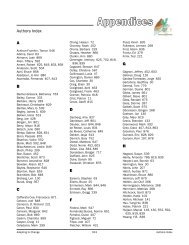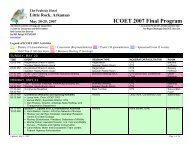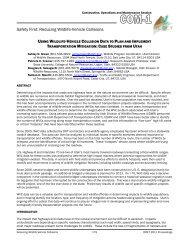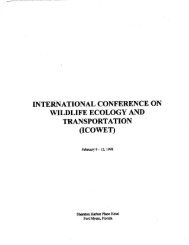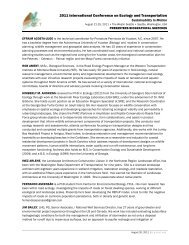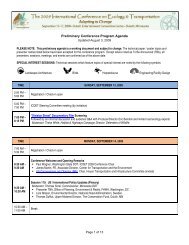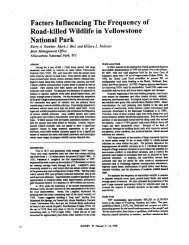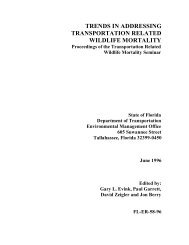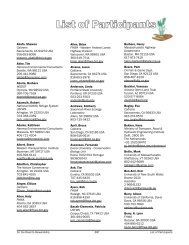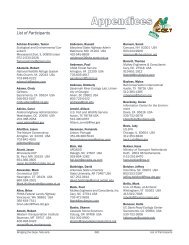Poster Sessions, pages 567-640 - ICOET
Poster Sessions, pages 567-640 - ICOET
Poster Sessions, pages 567-640 - ICOET
Create successful ePaper yourself
Turn your PDF publications into a flip-book with our unique Google optimized e-Paper software.
Background<br />
Major Objectives for Road Ecology to Benefit Transportation and Society<br />
Richard T. T. Forman (617-495-1930, rforman@gsd.harvard.edu), PAES Professor of Landscape<br />
Ecology, Graduate School of Design, Harvard University, Cambridge, MA 02138 USA<br />
Abstract: Pinpointing major objectives as a vision for transportation and society provides a cost-effective framework<br />
for numerous detailed solutions along the road network. Three major objectives, with road ecology a central player, are<br />
highlighted: (1) improve the natural environment close to the entire road network; (2) integrate roads with a sustainable<br />
emerald network across the landscape; and (3) integrate roads with near-natural water conditions across the landscape.<br />
These are briefly described along with examples of possible key steps ahead. In effect, this big picture or vision<br />
is a cost-effective route to achievement and benefit for transportation, the environment, and society.<br />
The world’s transportation infrastructure, a remarkable engineering accomplishment, was basically built before the rise<br />
of modern ecology. Now in an era of new scientific information and new societal objectives, transportation, science<br />
and the public have all moved well ahead. Enhancing the natural environment increasingly stands alongside safety and<br />
efficiency in transport as transportation’s central goal for the public.<br />
Not surprisingly, along with this major development, the science of “Road Ecology” has emerged, focusing on plants,<br />
animals and water related to roads and vehicles (National Research Council 1997, Forman et al. 2003, Forman<br />
2004). Decreasing the apparent drumbeat of public calls for environmental sensitivity in transportation plans and<br />
projects, planners, engineers, and managers increasingly find existing solutions, tested options, and solid ecological<br />
science readily available for application. Potential partners…transportation departments, natural resource agencies,<br />
academics, nonprofit organizations, and the informed public…are discovering common interests and opportunities for<br />
a new era of accomplishment. Project by project, countless locations along our road network ecologically improve, and<br />
environmental objectives increasingly receive emphasis in transportation plans.<br />
Yet the big picture has yet to coalesce and capture our attention. The greatest environmental gain and the greatest<br />
cost benefit for transportation and society are achieved by keeping our eye on the big picture—the major objectives—<br />
while we work project by project, location by location, and solution by solution. Three major objectives effectively tie<br />
the detailed solutions together in context, and provide the primary gain for transportation and society (Forman 2007a).<br />
Road ecology is central to all three.<br />
The Three Major Objectives<br />
1. Improve the natural environment close to the entire road network.<br />
2. Integrate roads with a sustainable natural emerald network across the landscape.<br />
3. Integrate roads with near-natural water conditions across the landscape.<br />
The first objective is a flexible trajectory rather than an end point, with different solutions in different locations. The<br />
second effectively meshes road networks with the land’s most-valuable large natural areas connected by major wildlife<br />
corridors to establish a combined sustainable pattern for the future. The third objective integrates road networks with<br />
the land’s water-bodies, groundwater/surface-water flows, aquatic ecosystems, and fish populations, so that an effective<br />
infrastructure and relatively natural surrounding water conditions are both sustained.<br />
The major objectives constitute a vision appealing to many potential partners and interested parties. The vision cannot<br />
be accomplished by the transportation community alone; collaboration with partners is essential, providing planning,<br />
project, policy, and public-relations values. Indeed, diverse interested parties with a common vision are an unbeatable<br />
recipe for powerful, cost-effective environmental accomplishments for transportation and society. Therefore, consider<br />
the three objectives more closely.<br />
Improve the Natural Environment Close to the Entire Road Network<br />
This objective emphasizes a trajectory of improvement rather than identifying and targeting a specific end product with<br />
success or failure. The rate of improvement varies from place to place. Location-by-location solutions along a road<br />
are appropriate (Bekker et al. 1995, Trocme 2003, Iuell et al. 2003, Forman et al. 2003, van Bohemen 2005). Roadsegment-by-road-segment<br />
solutions may often be more effective and cost efficient. Road-network-by-road-network<br />
approaches are likely to be especially valuable. The types of improvement stretch the imagination---habitat enhancement,<br />
vegetated stormwater-pollutant depressions, wildlife underpasses/overpasses, less-intensive mowing regimes to<br />
reduce invasive species, diverse deicing approaches, reduced air pollutants, aesthetic noise-attenuation techniques,<br />
and much more. Intriguing solutions for all of these currently operate in different nations. In essence, this objective<br />
can be accomplished with ample flexibility for transportation and great environmental gain for society.<br />
Integrate Roads with a Sustainable Natural Emerald Network across the Landscape<br />
This second objective emphasizes the most important solution known to protect and sustain biodiversity in a<br />
landscape with roads and vehicles, even in the face of urbanization and anthropogenic climate change. The central<br />
Bridging the Gaps, Naturally 597 <strong>Poster</strong>s






